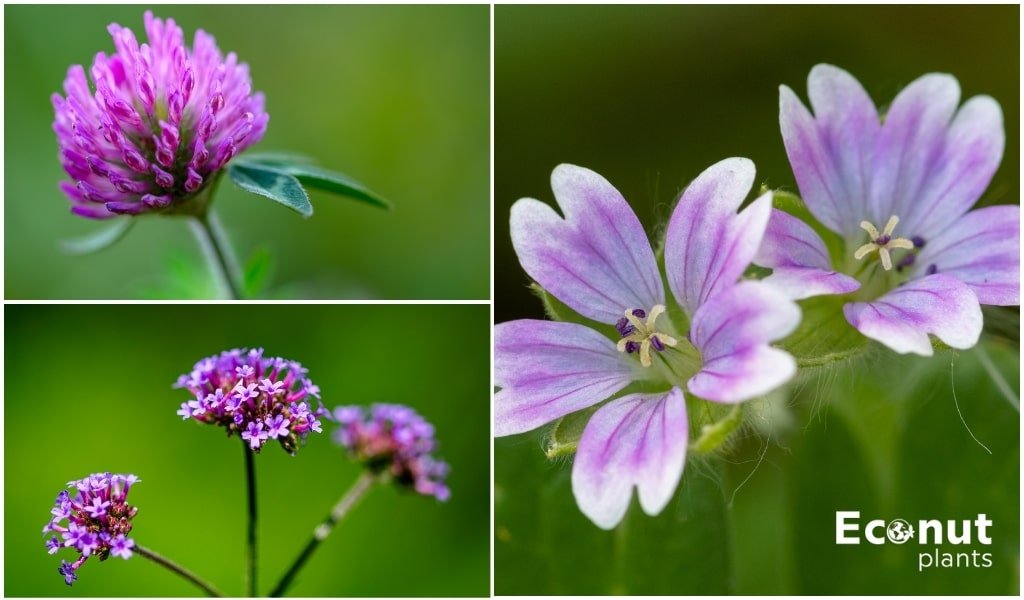You may or may not be aware of the numerous kinds of weeds that have purple blossoms. Your garden probably containsa wide variety of weeds, many of which, if you choose to embrace them, might provide several advantages.
In this article, we will explore different weeds with purple flowers to help identify plants in your garden.
What Are Purple Flowering Weeds?
Purple-flowering weeds are wild plants that have vivid purple flowers. The weedy plants usually grow in fields, gardens, or by the sides of roadways. They spread quickly, becoming invasive and suffocating native species.
Thistles, henbit, fireweed, and creeping Charlie are common purple-flowering weeds. Although these invasive plants damage natural ecosystems, they can also add beauty in unexpected locations.
1. Musk Thistle
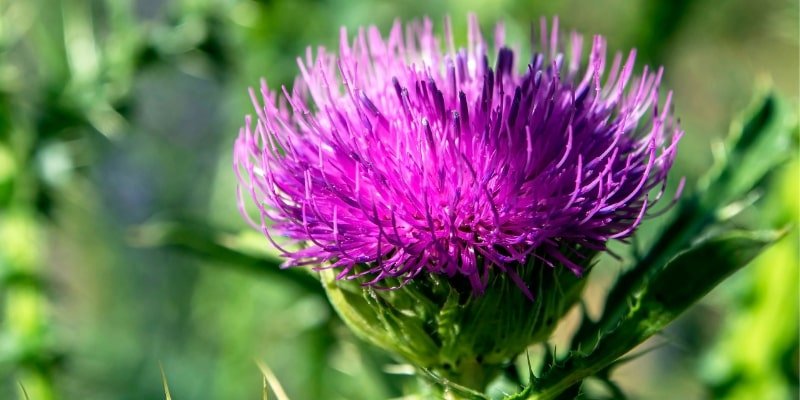
Scientific Name: Carduus nutans
Plant Type: Biennial plant
Plant size: 1½ to 6 feet tall
Sun needs: Full Sun
This purple-flowering noxious weed, sometimes known as nodding thistle, can be challenging to eradicate in backyards.
The distinctive characteristics of musk thistles include their robust root structure, dark green leaves with white prickly edges, and huge magenta-purple flower heads. Each plant bearing purple thistle blooms can yield more than 120,000 seeds annually.
Because of their almost uncontrollably fast growth and jagged leaves, musk thistles become a nuisance in gardens. Because they compete fiercely with natural plants for resources like sunlight, nutrients, and water, noxious weeds eventually drive them out. Furthermore, eradication is challenging and labor-intensive due to its strong, deep taproot.
2. Bittersweet Nightshade
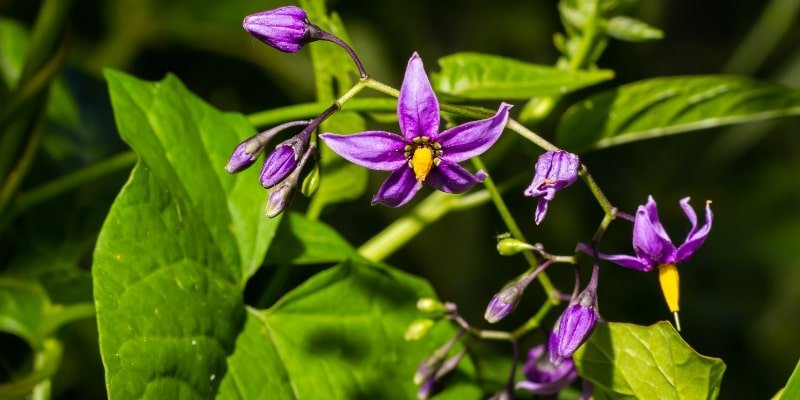
Scientific Name: Solanum dulcamara
Plant Type: Perennial vine
Plant size: 10 ft
Sun needs: Full Sun
The purple-flowering perennial vine, known as a bittersweet nightshade, is regarded as a weed because of its invasiveness and quick growth rate.
The little red berries, dark green ovate leaves, and clusters of purple flowers are characteristics that help identify this invasive species. Climbing quickly, the vine can reach heights of 10 feet (3 meters) and widths of 8 feet (2.4 meters).
Recall that every component of the bittersweet nightshade vine is poisonous when removing it by hand. Wearing gloves is therefore advised when handling the plant, as it may irritate the skin.
3. Dove’s-Foot Geranium
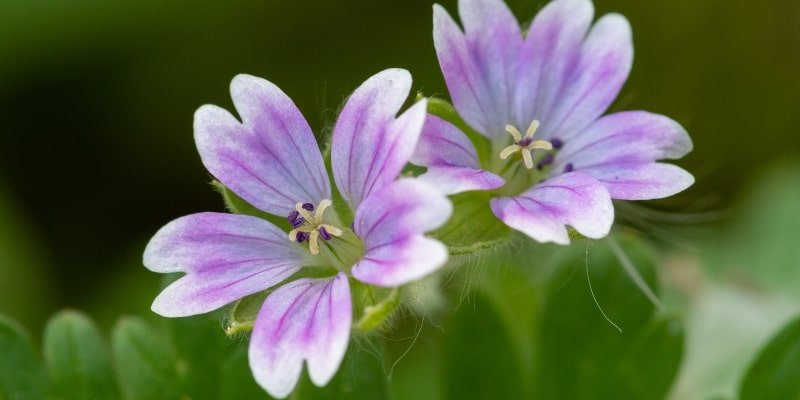
Scientific Name: Geranium molle
Plant Type: Annual herbaceous
Plant size: 5–30 cm
Sun needs: Full Sun
Common purple-flowering weed dove’s-foot geranium spreads quickly and takes root where you don’t want it to. The garden weed can only reach a height of 30 cm, or one foot.
The deep lobed, jagged leaves, low growth habit, and purple-pink flowers that bloom from April to September are characteristics of the purple weed. It’s crucial to manage a dove’s-foot crane’s bill to keep it from taking over your garden.
Seed dispersal is how the plant grows and spreads aggressively. In order to stop the blossoms from spreading widely throughout a garden, it is essential to remove them before they go to seed.
4. Purple Loosestrife
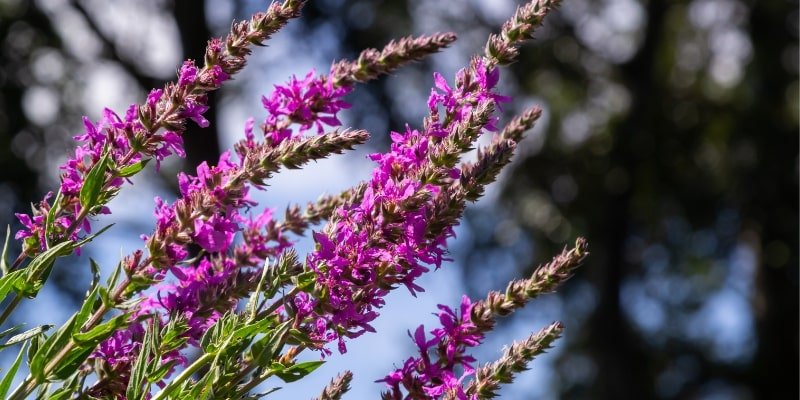
Scientific Name: Lythrum salicaria
Plant Type: Perennial
Plant size: 10 ft
Sun needs: Full Sun
Purple loosestrife is a perennial plant with purple flowers that is very invasive and poses a severe risk to wetlands and other natural areas.
This vigorous plant is distinguished by its lance-shaped leaves and tall, spectacular spikes of purple-pink flowers. Due to its prolific seed production—more than two million seeds are produced annually—it spreads quickly.
An invasive plant, weedy purple loosestrife, can reach heights of 2 to 4 feet (0.6 to 1.2 meters) and widths of 2 feet (0.6 meters). Cutting the plant to the ground in the middle of summer or deadheading it to stop it from self-seeding are two efficient control techniques.
5. Red Clover
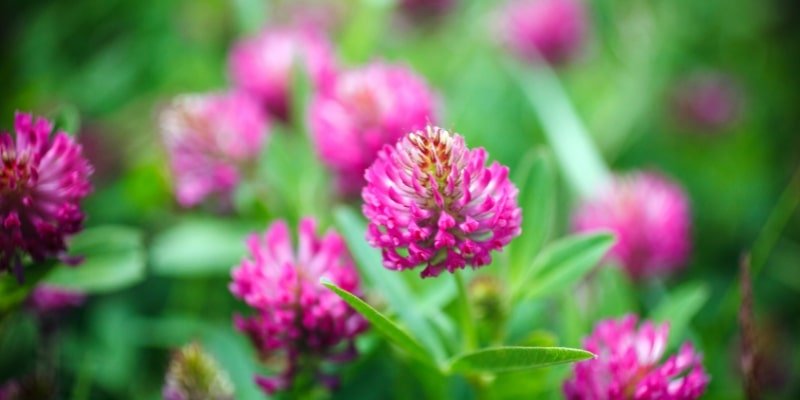
Scientific Name: Trifolium pratense
Plant Type: Perennial
Plant size: 20–80 cm (8–31 in) tall
Sun needs: Full Sun
Red clover is a common, short-lived perennial plant that invades lawns and garden beds with rose-pink or pinkish-purple flowers.
Clusters of purplish flowers, trifoliate leaves, and thin stems are characteristics that help identify this plant. Because of its thin stalk, red clover can spread swiftly and take over an area if not carefully handled. Since red clover draws pollinators and fixes nitrogen in the soil, it is frequently seen as a beneficial plant.
But when it overruns lawns or spreads to undesirable areas, it becomes a problem. With rhizomes, it spreads quickly and self-seeds readily.
6. Dame’s Violet

Scientific Name: Hesperis matronalis
Plant Type: Perennial
Plant size: 60-90cm
Sun needs: Full Sun to part shade
Dame’s violet is a very weedy, purple-flowering plant that spreads quickly and can be challenging to eradicate. Its lance-shaped leaves and aromatic spikes of pink, lavender, or purple flower clusters help identify this perennial purple plant.
This weed can reach a height of up to 3 feet (1 meter). Dame’s violet flowers emerge in the spring and have four petals that make a cross shape.
Due to its weedy character, it inevitably chokes out natural species and takes over yards. Controlling Dame’s violet blooms usually involves removing the plants by hand or excavating the entire plant, including the roots.
7. Common Burdock
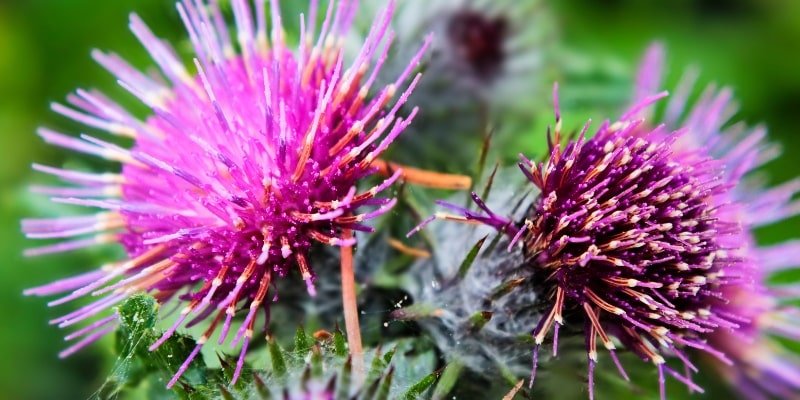
Scientific Name: Arctium minus
Plant Type: Biennial plants
Plant size: 3 to 7 feet tall
Sun needs: Full Sun to part shade
Common burdock is a weedy, biennial plant with purple flowers encroaching aggressively on gardens. Large, spherical, spiky purple flower heads and broad, heart-shaped leaves are characteristics of this unwelcome plant.
The weed grows quickly, reaching heights of 3 to 6 feet (1.8 to 1.8 meters). Its thick taproots are what give it its weedy appearance. Burdock is well known for its spiky burs, which are challenging to get rid of once the purple weed has taken hold.
It is essential to remove this hazardous plant before it goes to seed to completely eradicate it. Burdock can also be successfully removed by hand from gardens and landscapes.
8. Henbit

Scientific Name: Lamium amplexicaule
Plant Type: Herbaceous plants
Plant size: 6 to 15 inches
Sun needs: Direct Sunlight
Henbit is a purple-flowering plant that is often found in lawns and flower beds. This annual plant is characterized by square stems, tubular pink, purple, or lavender blossoms, and compound leaves that grow oppositely on stems.
The slow-growing purple weed can spread quickly if neglected. Henbit must be handled since it takes nutrients, water, and sunlight away from desired plants.
Manual removal of small infestations could be helpful. You can also mulch flower beds and the spaces around plants to prevent weed growth. Lawns can be kept lush and dense to help prevent henbit and keep this weed under control.
9. Blue Vervain
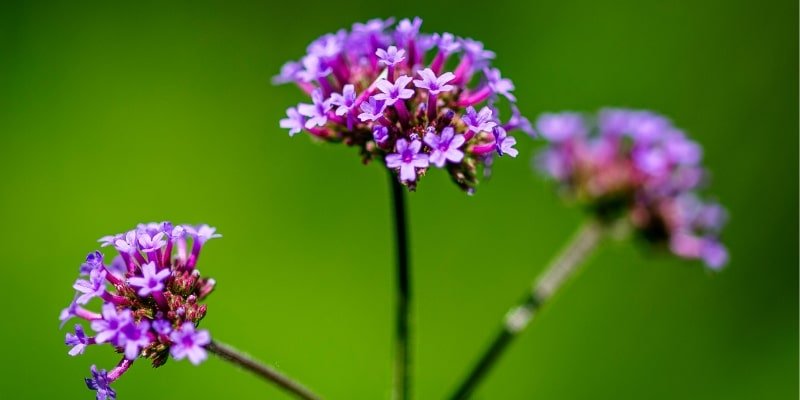
Scientific Name: Verbena hastata
Plant Type: Perennial
Plant size: 2 to 5 feet tall
Sun needs: Direct Sunlight
Blue vervain is a widespread perennial purple weed that grows in parts of your yard you don’t want it to.
Clumps of blue vervain proliferate and are low-maintenance perennials. The weedy plant, which grows 2 to 5 feet (0.6 to 1.5 meters) tall, is classified as a natural wildflower. It can withstand droughts and grows well in muddy, moist soils. Spring through summer is when it flowers.
This weedy, purple-flowering plant proliferates from seeds. To help control that plant, it is essential to remove the purple blossoms before they set seed.
10. Comfrey

Scientific Name: Symphytum officinale
Plant Type: Perennial
Plant size: 12-36 in. tall
Sun needs: Full Sun
A purple-flowering perennial plant that tends to form clumps, comfrey, can cause garden problems.
Comfrey makes an excellent ground cover plant that is full of light and has purple flowers. But because of its invasiveness, planting it requires caution. It can spread swiftly and does well in damp soil, partial shade, or the sun. The invasive perennial reaches a height of 1-3 feet.
Pulling the plant by hand is essential to try and remove all the roots in order to eradicate the spreading weed and its purple blossoms. Preventing comfrey from growing to seed is also crucial in order to stop its uncontrollable spreading.
11. Ground Ivy
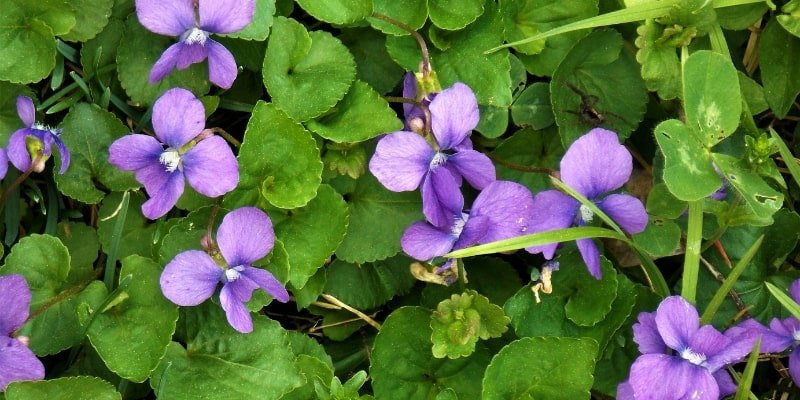
Scientific Name: Glechoma hederacea
Plant Type: Perennial
Plant size: 1 ft
Sun needs: Partial shade or bright indirect sunlight
This ground-hugging spreading ivy plant, sometimes called creeping Charlie, is a widespread perennial lawn weed with purple blooms. The mat-forming plant reaches a height of one foot (0.3 m) and blooms in the spring and summer.
The aggressively spreading branches of ground ivy root at the nodes and crawl upward. Without pesticides, weedy ivy is a complex plant to eradicate once it gets out of control.
One of the most challenging purple-flowering weeds to eradicate in yards is this plant because of its rapid growth, creeping, spreading habit, and tolerance for deep shade, sun, and poor soil.
12. Spotted Knapweed
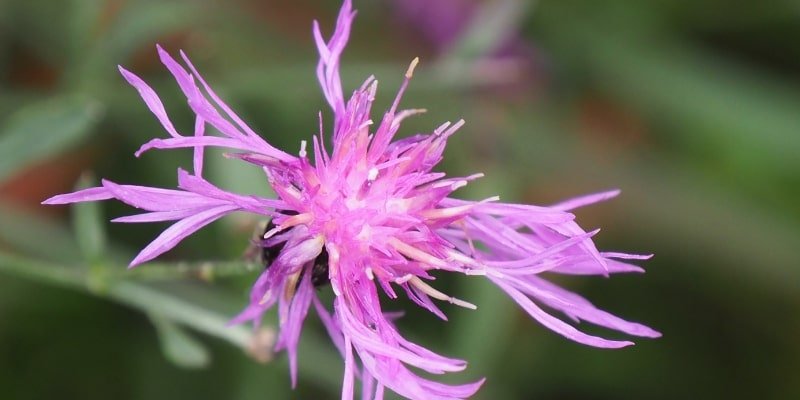
Scientific Name: Centaurea maculosa
Plant Type: Biennial or perennial plant
Plant size: 2- 4 feet tall
Sun needs: Full Sun
A very invasive purple-flowering weed that may swiftly take over flower beds is called spotted knapweed. The perennial weed is distinguished by its characteristic black spots on the flower bracts and thistle-like pink to purple flowers.
Since this kind of unwelcome plant grows best in dry soil, most gardens don’t have a serious weed problem. But its seeds can remain dormant in the ground for a number of years.
In a single growth season, the weed can reach 3 feet (1 meter). The plant has 8″ (20 cm) long, grey-silver leaves and 1″ (2.5 cm) tall purple-lavender blooms with spiky, black-tipped bracts.
13. Hedge Woundwort
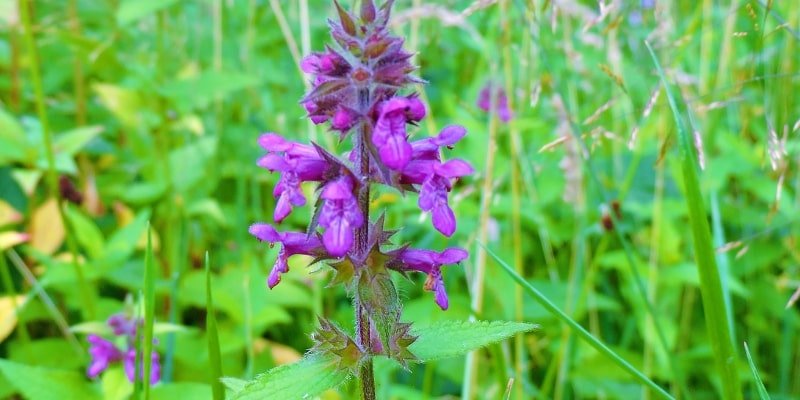
Scientific Name: Centaurea maculosa
Plant Type: Perennial
Plant size: 24 to 39 inches
Sun needs: Partial shade to full sunlight
The perennial flowering weed known as hedge woundwort is distinguished by whorls of purple flowers that bloom at the tips of its thin, leafy stems.
The weed, sometimes known as hedge nettle, has thin underground runners that can cause it to spread invasively in gardens and other landscape areas. Once established, this growth habit is hard to break.
Purple hedge woundwort weeds reach 0.3 to 1 m or 1 to 3 feet. Hedge woundwort, a non-native, grows well in shaded patches. Lawns can be effectively controlled by mowing, and tiny bed infestations can be manually weeded out.
14. Common Forget-Me-Not
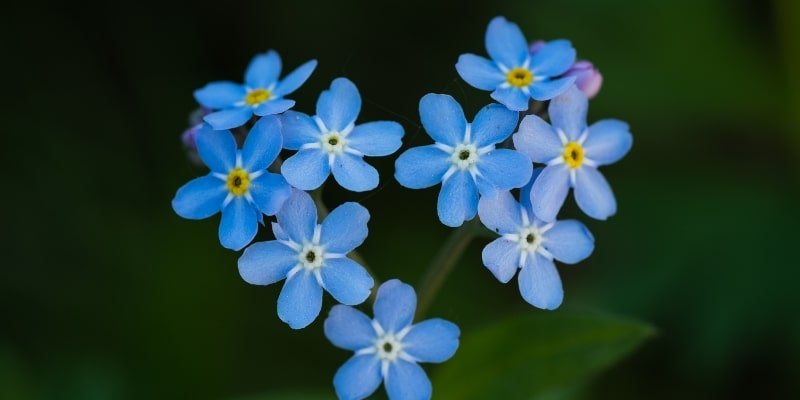
Scientific Name: Myosotis sylvatica
Plant Type: Perennial
Plant size: 2 feet (60 cm) tall
Sun needs: Full Sun
The common forget-me-not is a low-growing, weedy plant that has lovely, vibrant purple flowers with five petals. The blue or purple star-shaped flowers bloom in thick clusters throughout the spring and summer, with a golden center.
Forget-me-not plants are annual-like perennials with a brief lifespan. They can reach a height of 12″ (30 cm) and increase by self-seeding.
But to guarantee that the quickly resurgent purple blooms don’t return, vigilantes and persistence are essential for getting rid of the purple weed.
15. Deadly Nightshade
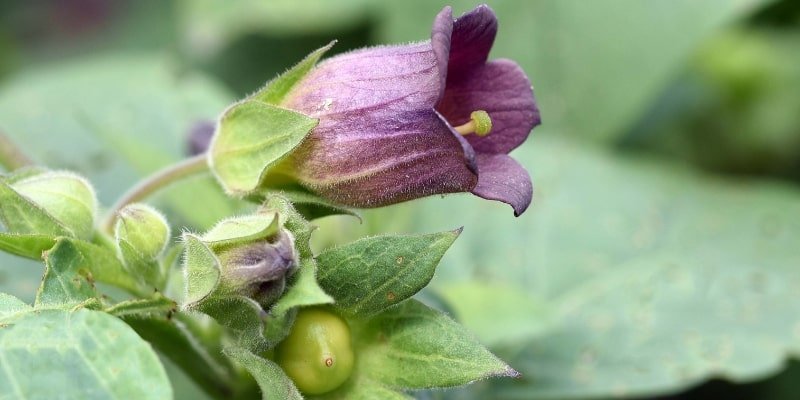
Scientific Name: Atropa belladonna
Plant Type: Perennial herbaceous
Plant size: 2 m (7 ft)
Sun needs: Full Sun
Deadly nightshade is a perennial weed with purple flowers that is highly toxic and invasive. This weedy plant can be recognized by its glossy black berries, dark green, ovate leaves, and bell-shaped purple blooms. The deadly nightshade has a height and width of 3 to 4 feet (1.2 m).
Deadly nightshade spreads quickly, dies in the winter, and then sprouts again in the spring. The key to managing deadly nightshade in gardens is to completely remove the roots. To prevent skin contact, protective clothing is essential.
Let’s say that a fatal nightshade infestation has emerged in your garden or yard. If so, seek professional advice for safe and efficient eradication techniques because purple weed is poisonous.

